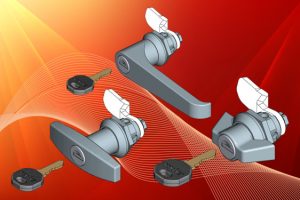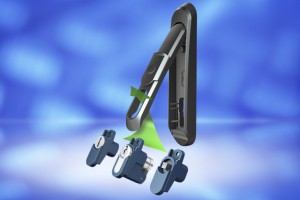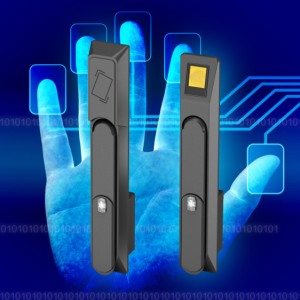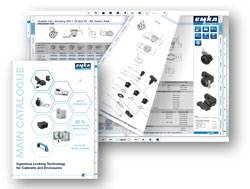By Andy Billingham, Managing Director – EMKA (UK) Ltd
In the area of industrial security new demands drive a continuous development process in tandem with new materials and production technologies. The demand can perhaps most easily be categorised as:
- Very low level – no access restriction but protection of personnel and equipment required – a simple wing knob latch may be sufficient.
- General access limited and equipment protection needed – but a simple key system is needed – perhaps a quarter turn lock with a triangular key.
- Restricted access and equipment protection – but low value or risk – a higher security key system is appropriate, a profile cylinder key lock would be a suitable choice.
- Higher risk or value – perhaps requiring an electronic mechanism eg specialist private manufacturing establishments or research centres.
- Very high risk/value e.g. data centres or utilities where a comprehensive logging/monitoring and control system is vital – remotely accessible e.g. via an encrypted internet link.
 In turn these have an effect on usage of materials and the design concept. In this respect the trend is toward increasing sophistication – it’s no longer acceptable to open a control or data cabinet with a screwdriver if you don’t have the key! So where once a wing knob latch was sufficient it is important to consider the need for keylocks – perhaps to IP65 or even IP69 and the option of vibration resistant compression locks which prevent nuisance door opening, as well as more complete gasket pull-down and consistently higher IP sealings.
In turn these have an effect on usage of materials and the design concept. In this respect the trend is toward increasing sophistication – it’s no longer acceptable to open a control or data cabinet with a screwdriver if you don’t have the key! So where once a wing knob latch was sufficient it is important to consider the need for keylocks – perhaps to IP65 or even IP69 and the option of vibration resistant compression locks which prevent nuisance door opening, as well as more complete gasket pull-down and consistently higher IP sealings.
Compression lock technology has tended to be rather confined to a limited range of applications until a few years ago it came out of patent protection and now a much wider market is finding it beneficial. EMKA have our own version of this technology and are able to bring our special expertise in design/manufacture to provision of many compression latch variants.
The question is simply “is a compression facility beneficial and where?” Well certainly the anti-vibration role of these locks is excellent in preventing opening of panels such as on trucks, railway rolling stock gensets, aircon and heating and ventilating systems. The answer is increasingly “yes”.
Compression lock/latches are valuable in environments where health and safety are critical in that people must be protected from the equipment they are operating and sometimes even from themselves. This is often a high priority where parallel developments in hygiene regulations have led to more use of stainless steel and designs without cavities which would collect debris and are so more easily cleaned – a move which has also led to increased use of high degrees of IP sealing to resist frequent high pressure washes. Here too developments in manufacturing technologies have enabled stainless steel and engineering plastics to be produced more cheaply, more accurately and with smoother more robust designs.
The ubiquitous ¼ turn latch lock changes incrementally as customers demand smooth, cavity-free designs suited to food processing plants and high sealing to withstand regular pressure washing.
Plastics are no longer in the dark ages and new generations of reinforced engineering grades enable tolerances to be reduced, leading to closer fitting, more robust assemblies which slide more easily with better operator feel and better sealing. These are now often the first port of call for corrosion resistant installations and so can frequently replace expensive metals.
Parallel developments continue elsewhere in enclosure hardware – it is amazing how usage has changed and how products have changed to meet those needs. For similar reasons – enhanced environmental requirements, cost and user friendliness – swinghandles are now produced with “O” rings and PUR seals giving excellent sealing for all applications. Glass reinforced polyamide was introduced as the industry developed slim, strong handle designs alongside stainless steel variants in AISI 304 or 316.
These reinforced machine grade plastics are extremely capable – such that robust antivandal designs are possible in these and in zinc die, sometimes in combination with components – often complimented by low profile escutcheons and inset handles for sealing and anti-tamper purposes.
We now have a variety of advanced mechanical solutions such as interchangeable lock cylinders which can be removed and replaced at any point in the installation process.
Innovation with regard to mainstream control and equipment cabinets or enclosures is exemplified in the 1325 swinghandle design which takes modular flexibility to a new level in this market. Designed specifically for electrical/electronic cabinets the stylish 1325 enables lock selection even after installation with a complete range of inserts to match common industry requirements.
 A significant feature here is this ability to swap the lock mechanism at any stage thus enabling flexibility at production and installation stages – even post installation. Along with a precision rod control system, the complete installation provides a quiet and robust operation resulting from optimal use of modern engineering plastics and manufacturing techniques.
A significant feature here is this ability to swap the lock mechanism at any stage thus enabling flexibility at production and installation stages – even post installation. Along with a precision rod control system, the complete installation provides a quiet and robust operation resulting from optimal use of modern engineering plastics and manufacturing techniques.
On the question of sealing we can now source pre-cut, pre-assembled and vulcanised gasket, installation-ready without messy cutting and gluing which has significant positive implications for sealing levels. EMC gaskets are mainstream, while a major demand has been identified for fire protection and high temperature gaskets in EPDM and silicone.
With increasing use of technologically driven solutions in all fields of industry the need for basic mechanical security is expanding rapidly and the new biometric/digital/card-based systems are finding their way “down” to levels where once a cheaper ¼ turn lock “would do”, but is no longer considered appropriate.
Simple electronically verified swinghandle based protection has been developed, along with networked systems which can be remotely monitored and authorised. The Agent E standalone wireless system is one approach for single or small numbers of cabinets – ideal for industrial controls.
 In most high security locations security problems begin with the fact that keys and key cards can become separated from their authorised users. Any key or key card that is forgotten, lost, stolen, or otherwise separated from an authorised user represents a potential, undetected security breach, while the greater the number of keys and key cards in a given environment, the greater the possibility of unauthorised access to physical systems or data asset.
In most high security locations security problems begin with the fact that keys and key cards can become separated from their authorised users. Any key or key card that is forgotten, lost, stolen, or otherwise separated from an authorised user represents a potential, undetected security breach, while the greater the number of keys and key cards in a given environment, the greater the possibility of unauthorised access to physical systems or data asset.
At the high tech end data has become extremely valuable so we have seen the need for 100% bullet-proof systems of monitoring, alarm and control leading to biometric technologies being applied at the cabinet door linked often to the
internet via encrypted channels.
Download “Enclosure Hardware Security Issues” as a pdf document



